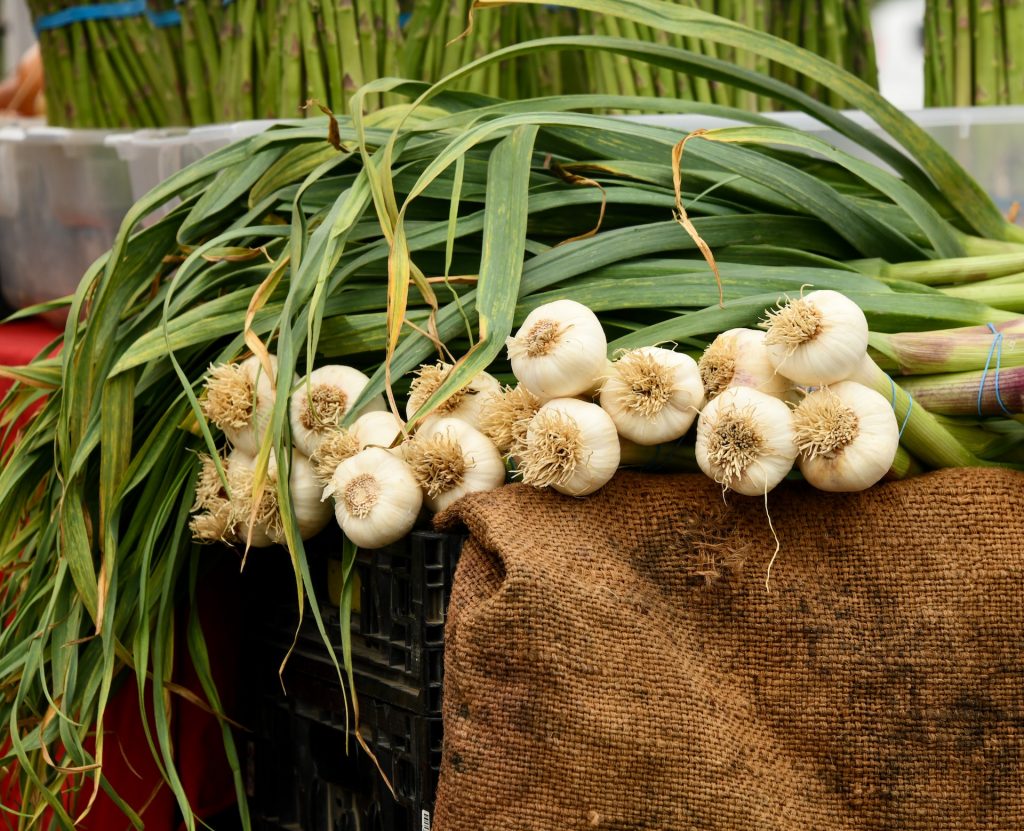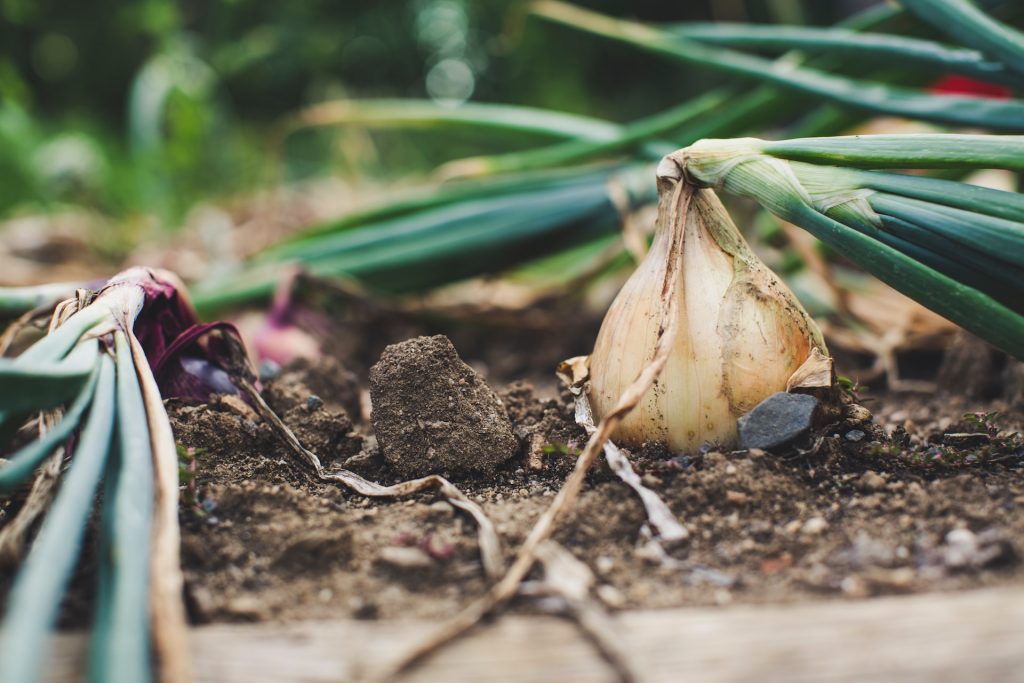Growing your own organic garlic is a fun and rewarding experience, but it can be challenging. There are so many things to consider when we want to plant and grow garlic at home that sometimes it’s easier just to buy it in the store. But after one tries growing organic garlic with their own hands, they’ll never go back! So let’s get started:
Planting and growing garlic at home.
Getting started with garlic is easy, as long as you know what you’re doing. Here are a few things to consider before planting garlic at home:
- Planting and growing garlic is not just for gardeners! If you have a sunny windowsill or porch, feel free to use it instead of the garden beds. You can also grow garlic indoors in pots on your kitchen counter.
- Don’t wait until the ground freezes over before planning out your wintertime crop of hardy harvests like kale and leeks—start now by planting some alliums (onions, shallots) in cold frames or greenhouses; they’ll be ready for harvest by early spring alongside fresh-picked greens from your garden’s salad bar.
When does one plant garlic?
You can plant garlic when the soil is moist, but not wet. The best time to plant garlic is when the soil temperature reaches 60°F (16°C). This means that you’ll want to plant your garlic as soon as you’re able to work in your garden in spring—ideally, by May 1st or so.
If you live in an area where there are distinct seasons, such as North America or Europe, this timeline will vary depending on where you live: if it’s warm enough and sunny enough outside for planting now then do so! If it’s still too cold and wet outside—don’t worry about it just yet. Wait until all danger of frost has passed before starting any new planting projects; this way everything can come together nicely and be ready for growth by summertime.
Once you’ve decided whether or not now is a good time for planting garlic then dig holes with a shovel (or whatever other tool makes sense) at least 8 inches deep into rich soil that drains well but also retains moisture; these conditions allow roots room to grow while still getting plenty of oxygen needed for healthy growth over long periods of time without drying out completely during dry spells like summers tend towards being like sometimes here in southern California where I live most days year round since we don’t see much change between seasons except maybe some rain showers every few weeks which only last twenty minutes tops before turning back into sunshine again.”
Can I just use supermarket garlic for planting?
While garlic purchased from the supermarket is often cheaper, it’s not suitable for planting. Garlic cloves purchased from your local grocery store have probably been treated with chemicals to delay sprouting and keep them fresh longer. These chemicals may not be safe for planting, so you should avoid using supermarket-bought garlic cloves for this purpose.
Instead, look for garlic at garden centers or online (for example, Amazon has several varieties of garlic cloves that are certified organic).
How do I pick out the right variety of garlic to grow?
Once you’ve decided to grow your own garlic, it’s time to select the right variety. Selecting the right garlic depends on three factors: climate, soil type, and taste preferences.
To select a variety based on climate conditions:
- If you live in a warm climate (USDA zones 8–9), choose hardneck varieties like Porcelain and Music that store six months or longer without refrigeration.
- If you live in an area with cold winters (USDA zones 4–7), choose softneck varieties like Creole, Artichoke and Silverskin that store four months or longer without refrigeration.
To select a variety based on soil type: * Garlic grows best in well-drained soils with moderate fertility levels; sandy loam is ideal for most growing regions throughout North America. Clay soils are generally not suitable for growing garlic unless they have been amended with organic matter at least two years before planting. If your soil is heavy or poorly drained, amending it will help improve drainage before planting garlic bulbs next fall—add 3–4 inches of compost to the topsoil before laying down newspaper sheets over them (about 8 sheets per square foot).
How long does growing garlic take?
You can start growing garlic in the spring and summer, or in the fall and winter.
The best time to plant garlic is in the late fall, when soil temperatures are cool enough that the cloves will not rot.

How deep do you plant garlic cloves?
- Plant garlic cloves up to 2 inches deep.
- Create a trench or furrow, and plant the garlic in rows 12 inches apart.
- After planting, cover the soil with straw or other mulch to protect it from weeds, keep moisture levels consistent, and reduce wind damage—but don’t cover too much: you want your plants to be able to grow some roots!
How far apart should you plant garlic cloves?
If you’re planting garlic in rows, plant the cloves 3-5 cm apart and 30-40 cm apart. This spacing allows for good airflow around the plants and prevents them from getting too crowded, which can result in lower yields.
If you’re planting garlic in a single layer, plant each clove 5 cm deep and 10-15 cm apart from one another. Be sure to loosen the soil before planting so that it’s not compacted around the cloves.
Where’s the best place to plant garlic cloves?
Garlic is a hearty plant and thrives in full sun. It does not do well in shade or under trees, which can cause it to become sunburned. Garlic also needs good drainage as it does not like soggy soil. In addition, garlic plants do not like hot dry conditions or cold wet conditions, so be sure to plant your cloves in the right spot!
What kind of soil is best for growing garlic?
Garlic is in the Allium genus, which includes onions and leeks. Garlic plants prefer well-drained soil that is neither too rich nor too poor. The best soil for growing garlic is neutral to slightly acidic (pH 6 – 7), rich in organic matter, relatively high in nutrients and free of pests and diseases.
You can grow garlic in almost any kind of soil as long as it’s well drained. Just be sure to add plenty of organic matter such as compost before planting your cloves so they are not overwhelmed by mineral salts from an overabundance of nitrogen or phosphorous from chemical fertilizers used on other crops nearby.

Can I grow organic garlic from home organically and naturally?
Yes, you can grow organic garlic from home organically and naturally. You will need to use organic soil and you should not use pesticides or fertilizers. You should also avoid using herbicides, which kill weeds and plants in your garden.
When choosing an organic fertilizer for your garlic:
- Look for a fertilizer that contains all natural ingredients, such as alfalfa meal, cottonseed meal, fish emulsion and seaweed extract.
- Avoid any fertilizer that contains synthetic nitrogen or nitrate as these products are harmful to the environment when they are washed into lakes and rivers by rainwater runoff during heavy rains.
Do I need to add fertilizer when growing garlic from home?
If you’re growing garlic from home, it’s important to remember that fertilizer helps the plant grow better. Garlic is a heavy feeder and needs more nutrients than most plants. Fertilizer will also help with pest control, which can be helpful if you’re dealing with lots of insects in your garden.
So yes, adding fertilizer when growing garlic at home is a good idea as long as you choose organic fertilizers such as:
- Worm castings (made by composting worms)
- Seaweed meal
- Chicken manure
Is it important to mulch around my plants when growing organic garlic from home?
Mulching is a layer of material that is put on top of the soil to help retain moisture and inhibit weed growth. Mulch can be made from many different materials, such as wood chips, bark, straw and grass clippings.
If you choose to mulch around your garlic plants to keep weeds down, consider using an organic mulch like hay or composted manure. These will decompose into nutrients that can improve your soil over time.
What are the pests that come with growing organic garlic at home, and how can I get rid of them without using pesticides, if possible.
You can get rid of aphids with a mixture of water and soap. Mix one part liquid dish soap to three parts water, then spray the affected plants. You can also use neem oil, which is a natural insecticide that will help control aphids.
Thrips are also fairly common in garlic gardens, and they can be treated with neem oil as well.
Leaf miners are moths that lay eggs inside leaves and larvae eat their way out after hatching. To get rid of them, try using diatomaceous earth on your plant’s soil to kill off any larvae hiding there; this will not harm pets or children who might come into contact with it either!
Should I water my plants when they’re young? As they mature? And how often is ideal when growing organic garlic at home.
It’s important to understand when and how often you should water your garlic plants. If you’re new to growing organic garlic at home, the easiest way to make sure they’re getting enough water is by hand. Simply dig down into the soil around them with your fingers until they’re covered in moisture. If they don’t feel wet, add some more water until they do.
Watering young plants more frequently is generally recommended because it encourages growth and helps prevent disease in those crucial first few weeks when the plant is getting established. Once a plant reaches maturity (roughly eight weeks after planting), watering frequency can decrease to once per week or every two weeks depending on how dry your climate is and how hot it gets during that time period.
There are a lot of little things to know in order to successfully grow your own organic garlic
Growing garlic is easy, especially if you have a lot of space and the right soil. If you follow the instructions, you should be able to grow organic garlic in your own backyard.
However, there are a lot of little things to know in order to successfully grow your own organic garlic at home. Here are some tips for growing that delicious bulb:
- Be patient! Garlic takes about six months from planting time until harvest time, so plan on being patient with this plant and its growth timeframe before popping it into your mouth.
- Make sure that you have enough space for each individual plant—a single clove can produce up to twelve heads!
Conclusion
I hope that this guide has been helpful for you and your family. Growing garlic at home is a great way to save money, get fresh organic vegetables and herbs, and even make some extra cash. If you follow these tips, there’s no reason why you can’t have a successful crop of your own! Good luck!







